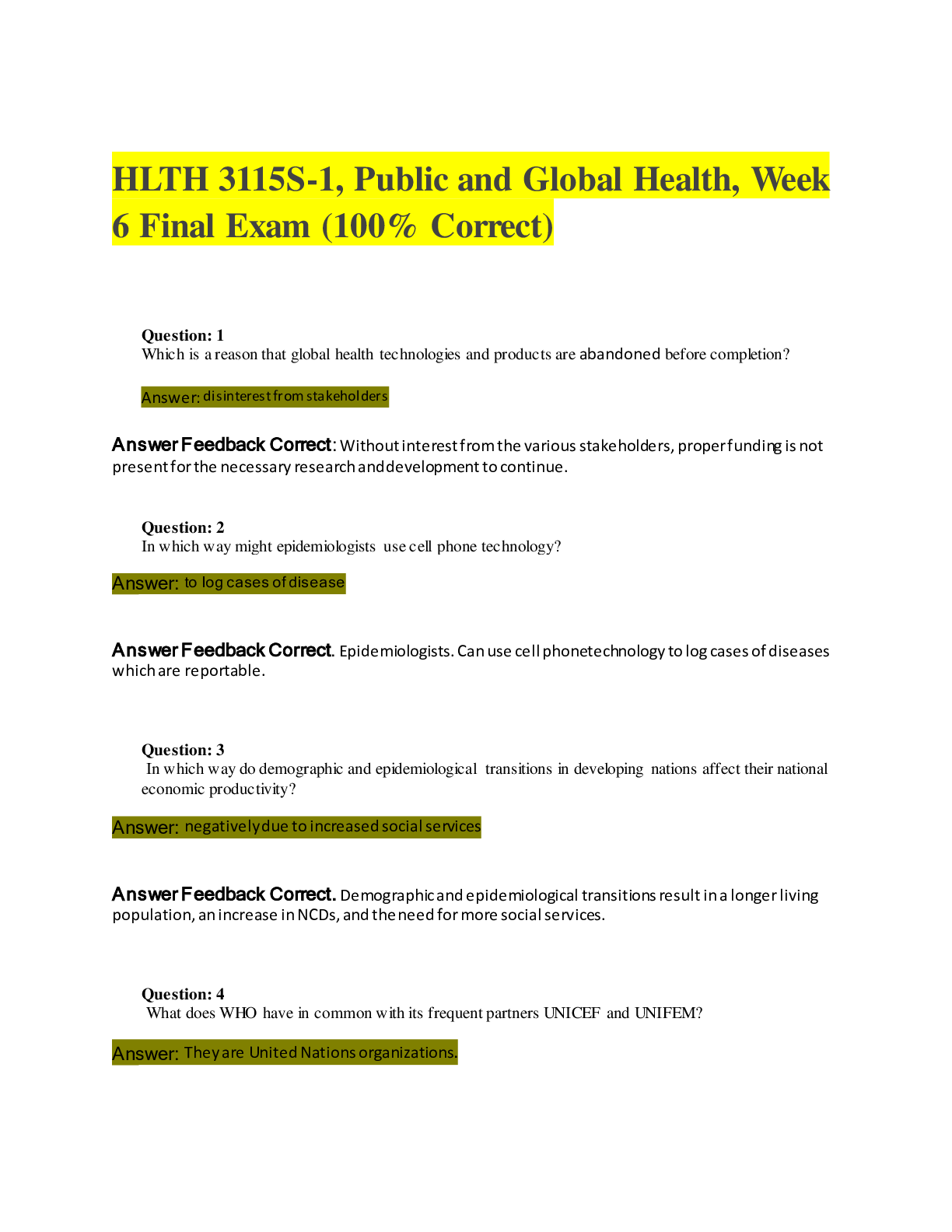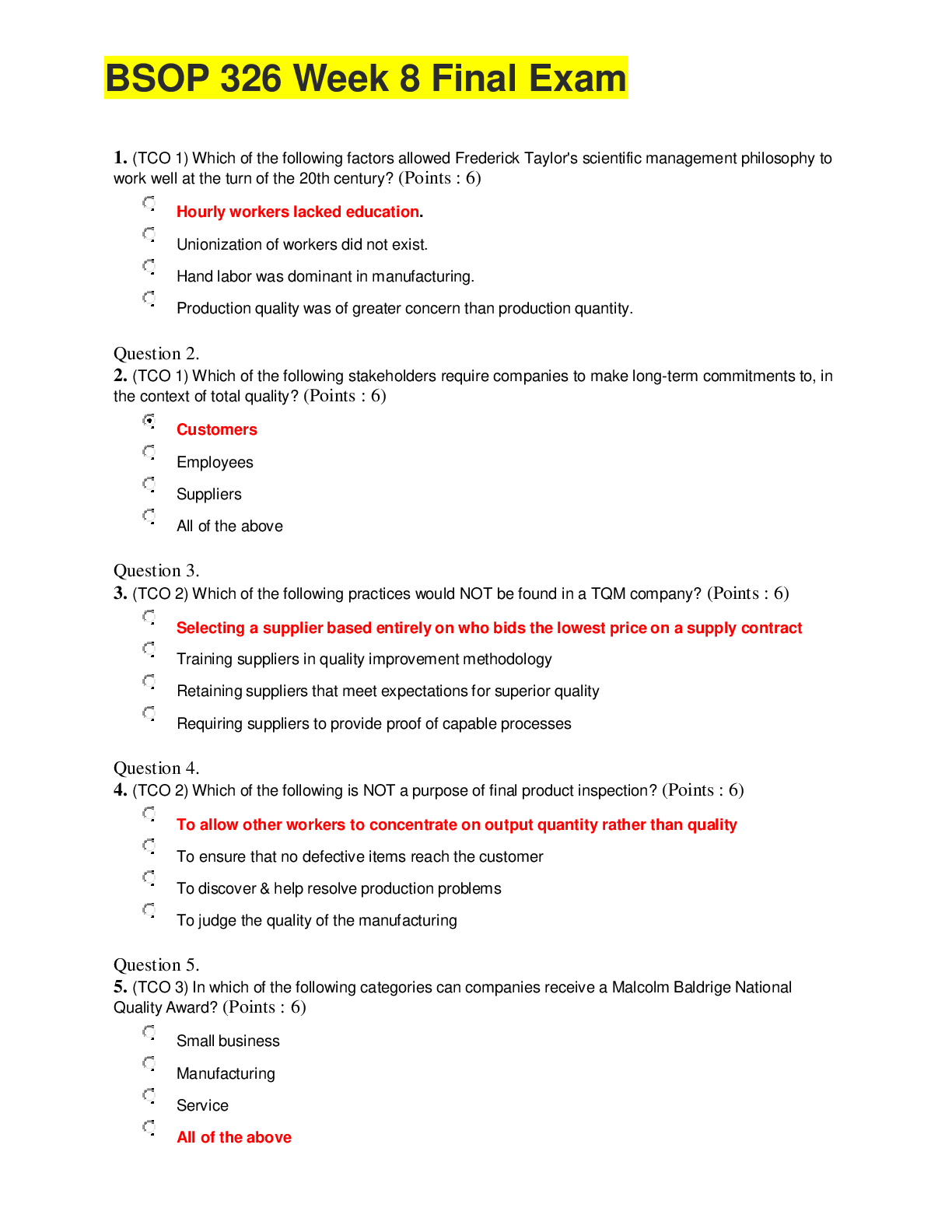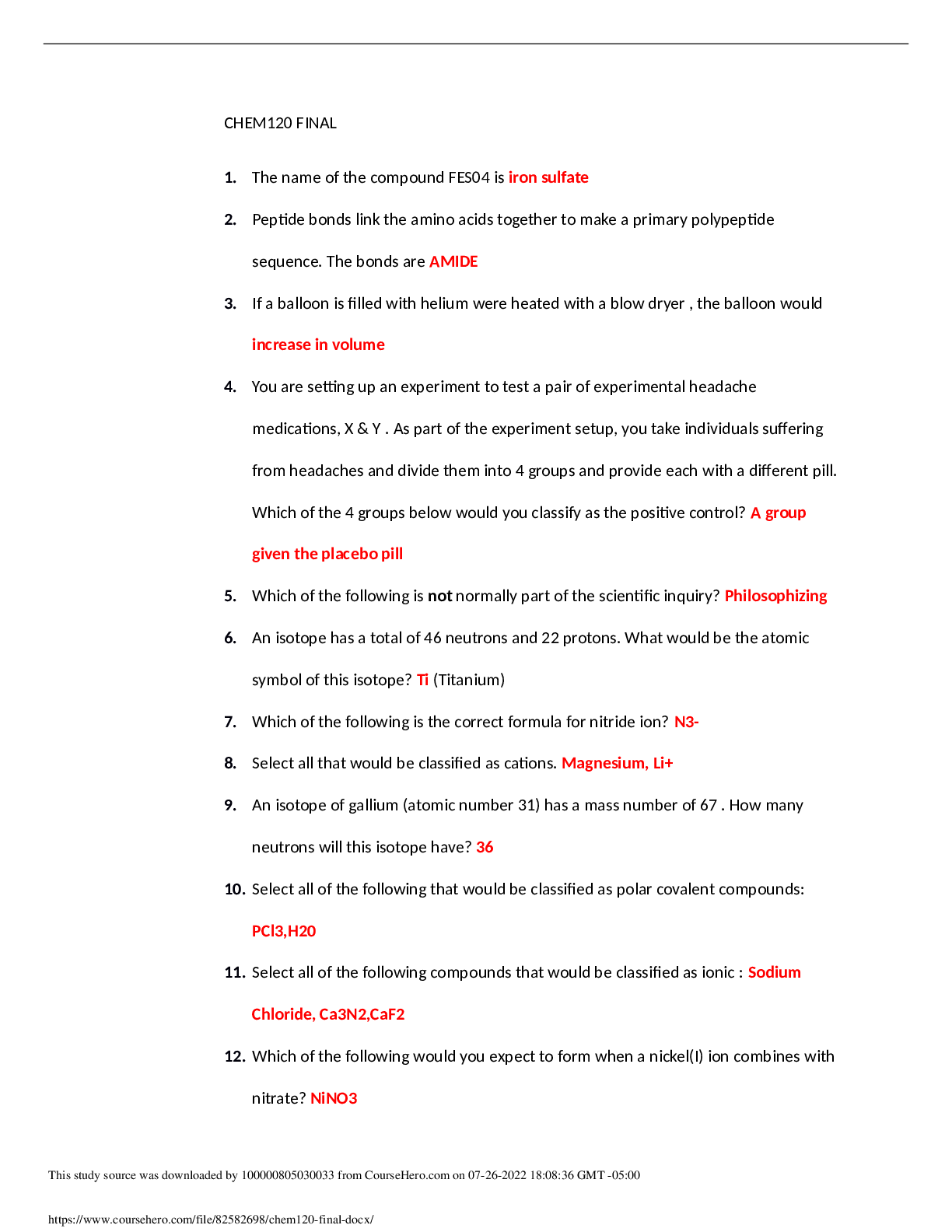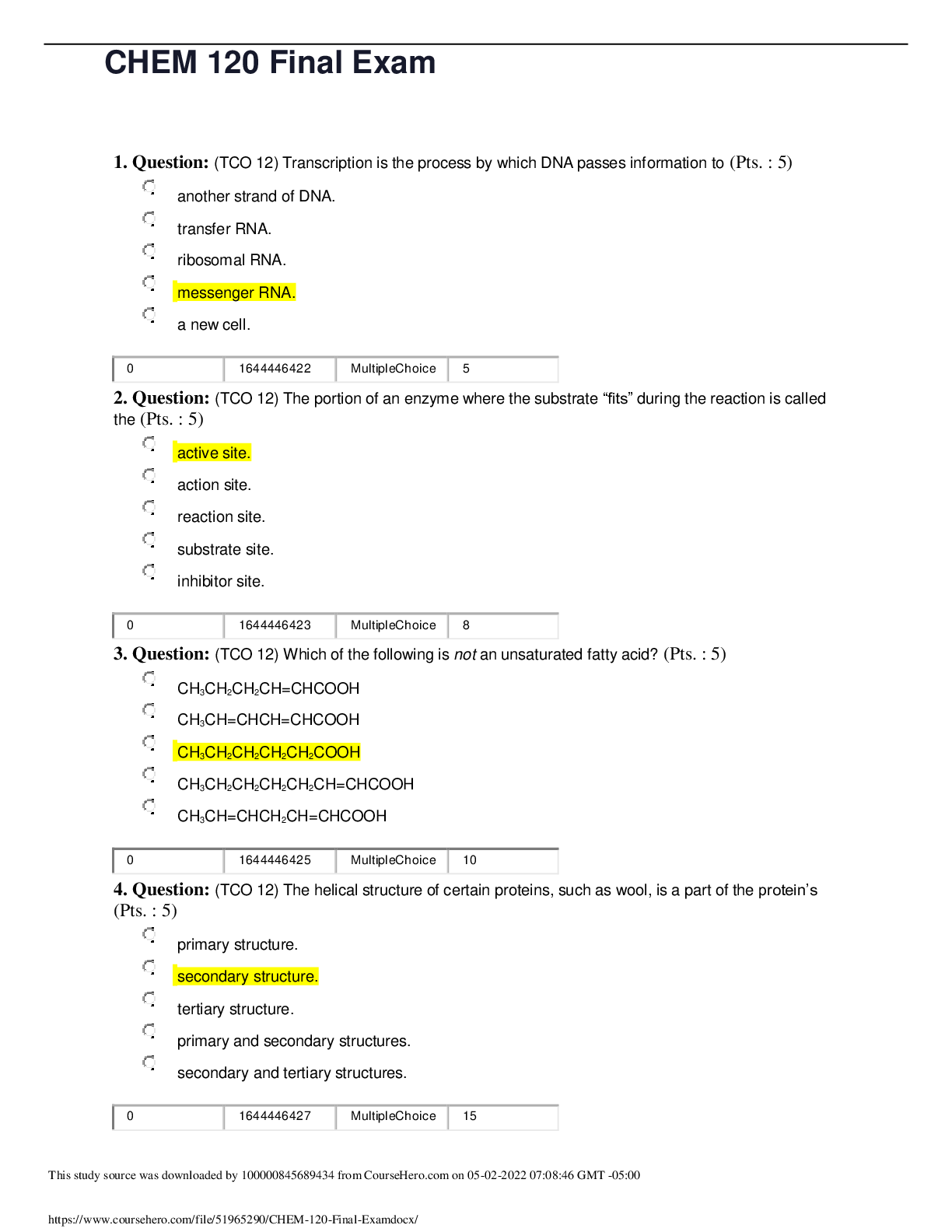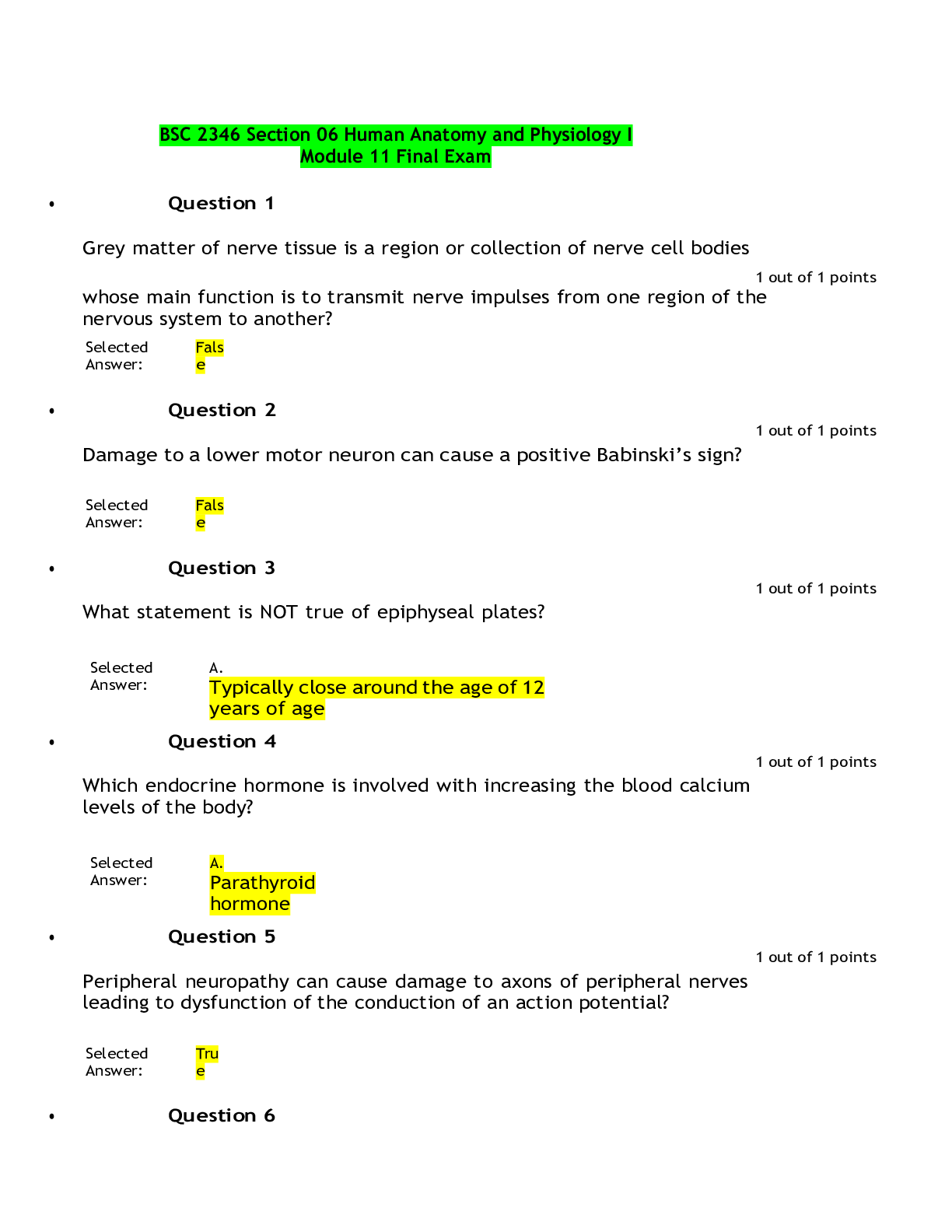BIOS 195 Final Exam (100% correct answers)
Document Content and Description Below
BIOS-195 FINAL EXAM (TCO1) Which of the following is an example of a positive feedback system in the human body? Answer: Childbirth (TCO1) Which of the following molecules contains the sugar deoxyr... ibose? Answer: DNA (TCO2) Glucocorticoids, such as cortisol, are steroid hormones produced by the Answer: adrenal cortex. (TCO3) Which of the following organelles is primarily associated with mitosis and meiosis? Answer: Centrioles (TCO3) Glands that have openings directly onto bodily surfaces are classified as Answer: exocrine glands. (TCO4) The digestion of carbohydrates into monosaccharides starts in the Answer: oral cavity. (TCO4) Which of the following hormones are the main regulators of the basal metabolic rate (BMR)? Answer: Thyroid hormones (TCO5) The site of production of blood cells is in the Answer: red marrow of the bone (TCO6) The transmitter that is released at the neuromuscular junction of skeletal muscle fibers is Answer: acetylcholine. (TCO6) Muscle fatigue can be caused by Answer: All of the answer choices are correct. (TCO7) Which of the following is NOT a component of the peripheral nervous system? Answer: Spinal cord (TCO7) The neuroglia that are specialized to produce the myelin sheath around axons in the peripheral nervous system are the Answer: Schwann cells. (TCO7) The stage of an action potential that is characterized by the activation of the sodium-potassium pump is the Answer: repolarization stage. (TCO7) A neurotransmitter that hyperpolarizes the postsynaptic membrane would be classified as a(n) neurotransmitter. Answer: Inhibitory (TCO7) A disorder in which an individual experiences sudden paralysis resulting from macrophage destruction of the myelin sheath around peripheral nervous system axons is called Answer: Guillain-Barre syndrome. (TCO7) Damage to the choroid plexus would interfere with Answer: formation of cerebrospinal fluid. (TCO7) The cervical enlargement of the spinal cord contains neurons that supply the Answer: arms and hands. (TCO7) Common effectors of autonomic reflexes include Answer: both smooth and cardiac muscle. (TCO7) Which of the following areas of the brain is sometimes referred to as the emotional brain? Answer: Limbic system (TCO7) The primary somatosensory cortex is located within the lobe of the cerebral cortex. Answer: Parietal (TCO7) The process in which the strength of a sensation decreases during prolonged stimulation is referred to as Answer: adaptation. (TCO7) Olfactory signals are transmitted to the cortex via the cranial nerve Answer: I (TCO7) Accommodation for near vision involves changing the shape of the Answer: lens. (TCO7) The receptors for hearing are located on the Answer: organ of Corti. (TCO7) The structure that carries tears from a lacrimal gland onto the surface of the eye is called a Answer: lacrimal duct. (TCO8) The type of protein that is most plentiful in blood plasma is called Answer: albumin. (TCO8) The protein in red blood cells that is specialized to carry oxygen is called Answer: hemoglobin. (TCO8) The first phagocytic cells to arrive at a site of bacterial infection are the Answer: neutrophils. (TCO8) Platelets are disc-shaped, formed elements in the blood that are generated by splintering a large cell called a into about 2,000-3,000 fragments. Answer: Megakaryocyte (TCO8) Oxygenated blood is delivered to the myocardium of the heart by the Answer: coronary arteries (TCO8) Which of the following vessels carries blood with the highest concentration of oxygen under normal circumstances? Answer: Pulmonary veins (TCO8) The P wave of an ECG is created by the electrical activity associated with Answer: atrial depolarization. (TCO8) At a normal resting heart rate, each cardiac cycle lasts approximately Answer: 0.8 seconds. (TCO8) The smallest diameter blood vessels are Answer: capillaries. (TCO8) The baroreceptors involved in blood pressure regulation are located in Answer: both the aorta and internal carotid arteries. (TCO8) The lowest blood pressure typically occurs in the Answer: veins. (TCO8) Which of the following hormones influences blood pressure? Answer: All of these hormones influence blood pressure. (TCO9) Which of the following structures in the respiratory system is commonly called the Adam's apple? Answer: Thyroid cartilage (TCO9) The false vocal cords Answer: None of these answer choices is correct. (TCO9) Painful or labored breathing is referred to as Answer: dyspnea. (TCO9) Which of the following factors affect the release of oxygen from hemoglobin? Answer: All of these answer choices are correct. (TCO10) The renal pyramids are located in the Answer: renal medulla. (TCO10) The first portion of the renal tubule emerging from the glomerular capsule is the Answer: proximal convoluted tubule. (TCO10) The distal convoluted tubules empty directly into the Answer: collecting duct. (TCO10) An increase in the osmolarity of body fluids due to dehydration is sensed by osmoreceptors in the , triggering the release of from the posterior pituitary. Answer: hypothalamus; ADH (TCO10) The initial trigger for the onset of puberty in both males and females is increased secretion of Answer: testosterone or estrogen from the gonads (TCO10) Approximately 60% of the volume of semen is produced by the Answer: seminal vesicles. (TCO10) All of the following are structures associated with the mammary glands EXCEPT the Answer: infundibulum. (TCO10) Menstruation is directly caused by a decrease in the ovarian secretion of Answer: progesterone and estrogens. (TCO10) The muscular structure that separates the uterine body from the vagina is the Answer: cervix. (TCO7) Describe the process of neuronal impulse conduction in unmyelinated and myelinated axons. Answer: In unmyelinated axons, impulses travel by continuous conduction, which means that the action potential in one area causes depolarization of the adjacent area. This step-by-step depolarization is slower conduction than occurs in myelinated axons. In myelinated axons, depolarization occurs at the nodes of Ranvier and impulses jump from one node to the next. This type of conduction is called saltatory conduction. (TCO7) Name and describe the locations and functions of the meninges. Explain the process of a spinal tap. Answer: The dura mater is the outermost layer and consists of tough, dense, irregular connective tissue. The arachnoid is the middle layer arranged in delicate webs of collagen and elastic fibers where the CSF circulates. The inner layer is the pia mater, a transparent layer of collagen and elastic fibers that is tightly connected with the outside of the brain. A spinal tap removes csf from the CNS below the level of the cauda equine so that there is no danger of injuring the spinal cord. A needle is inserted between adjacent vertebrae into the subarachnoid space and fluid is withdrawn into a syringe for analysis. (TCO8) What are the main differences between the pulmonary and systemic circulatory systems? Answer: In systemic circulation, low O2 causes dilation of the blood vessel walls. This will lead to an increase in O2 delivery to tissues. In pulmonary circulation, the opposite occurs in response to low levels of O2. The pulmonary vessels constrict to ensure that blood only goes to those alveoli that are receiving rich O2 supply and avoids poorly ventilated sacs. The pulmonary system is reversed in that oxygenated blood is in the pulmonary veins and deoxygenated blood is in the pulmonary arteries. The pulmonary loop has lower systolic and diastolic pressure when compared to the systemic loop. (TCO9) Name and briefly describe the three basic processes of respiration. Answer: (1) Pulmonary ventilation (breathing) is the movement of air in and out of the lungs due to contraction and relaxation of muscles that control the size of the thoracic cavity. (TCO10) Describe the differences between tubular reabsorption and tubular secretion. Answer: Tubular reabsorption involves the movement of water and solutes from the tubular fluid back into the blood in the peritubular capillaries. Tubular reabsorption is a process of reclaiming what the body wants to keep. Tubular secretion involves the movement of solutes from the blood in the peritubular capillaries into the tubular fluid for excretion in the urine. Tubular secretion is a process of pumping waste products into the urine at a faster rate than they would enter the tubular fluid by glomerular filtration. [Show More]
Last updated: 1 year ago
Preview 1 out of 3 pages
.png)
Reviews( 0 )
Document information
Connected school, study & course
About the document
Uploaded On
Oct 26, 2022
Number of pages
3
Written in
Additional information
This document has been written for:
Uploaded
Oct 26, 2022
Downloads
0
Views
22






.png)










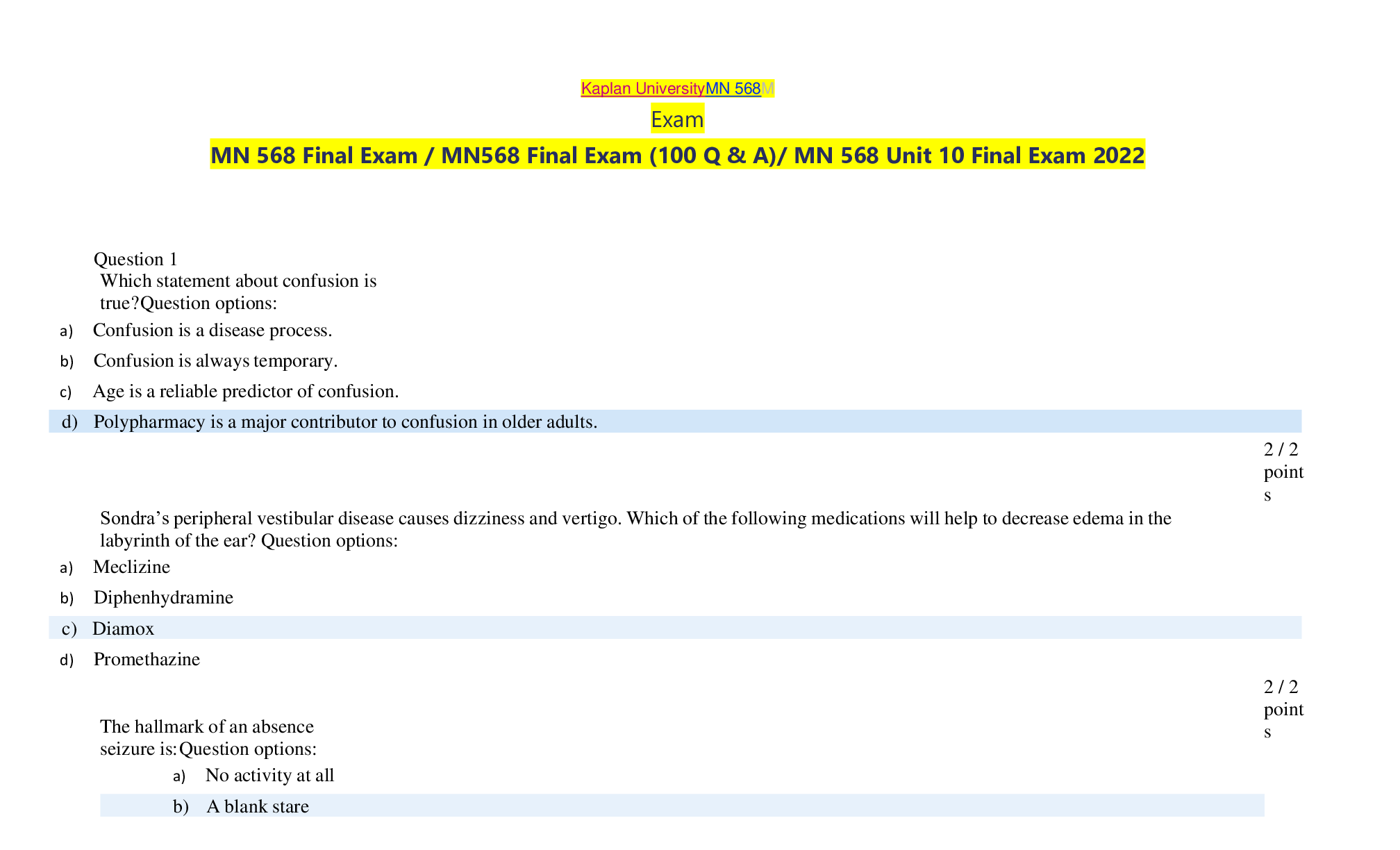
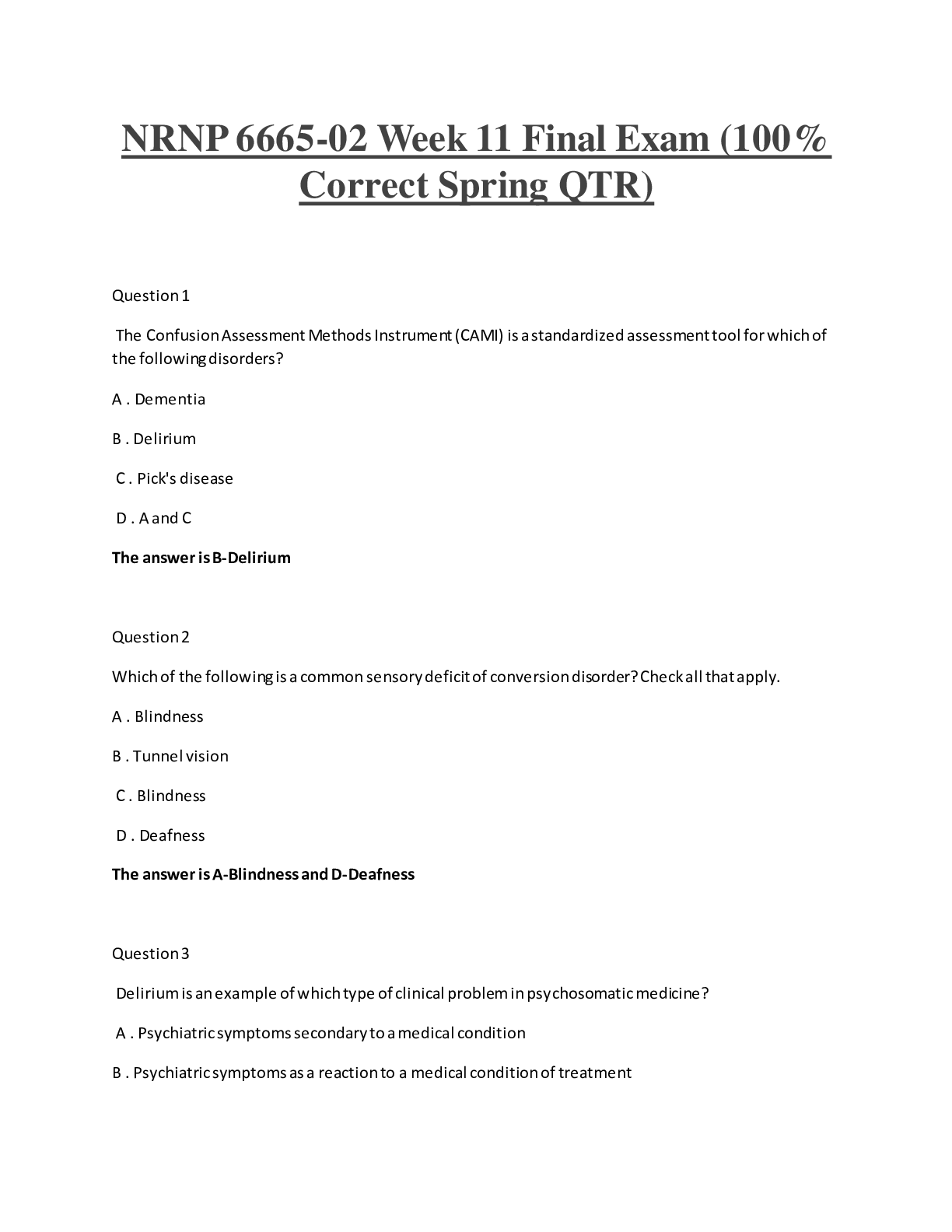
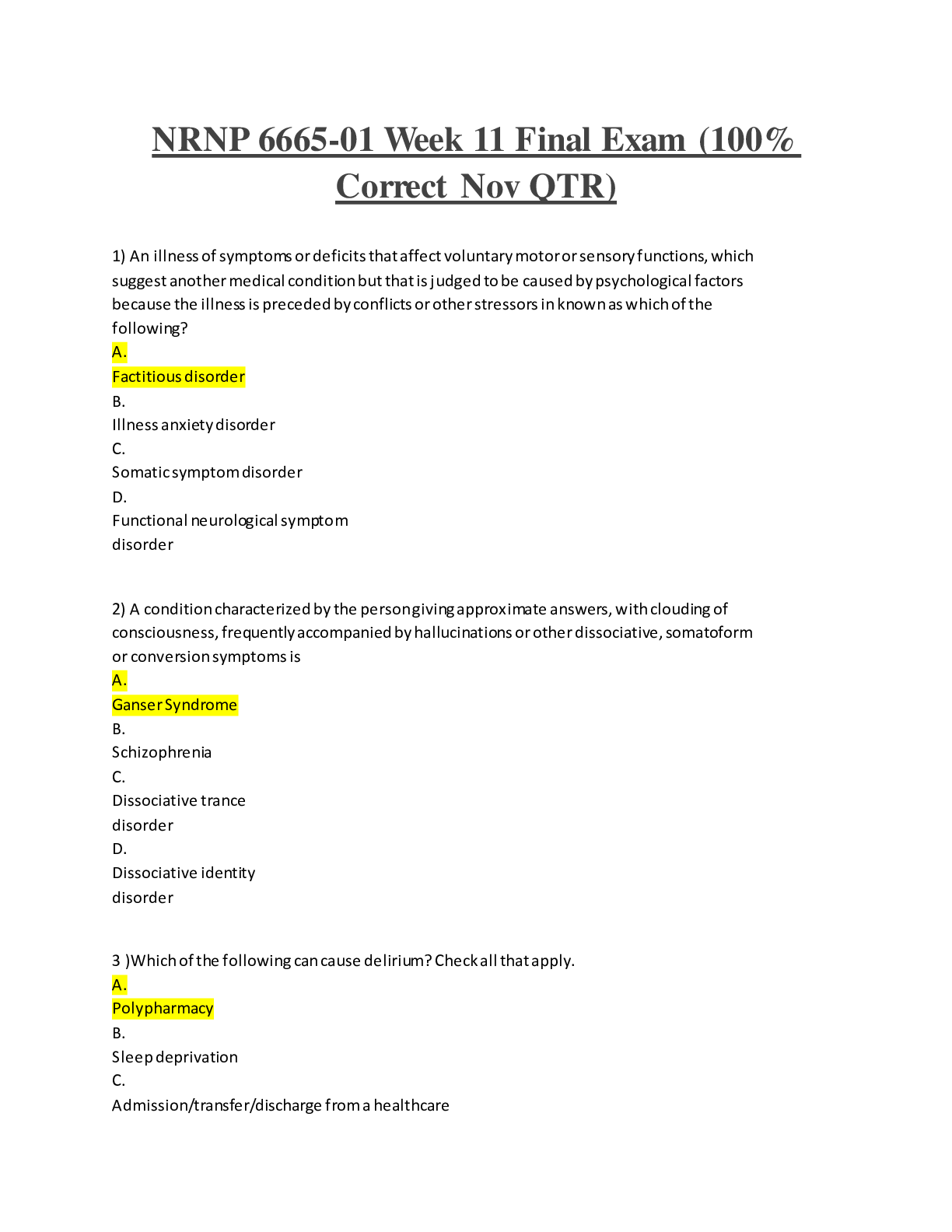




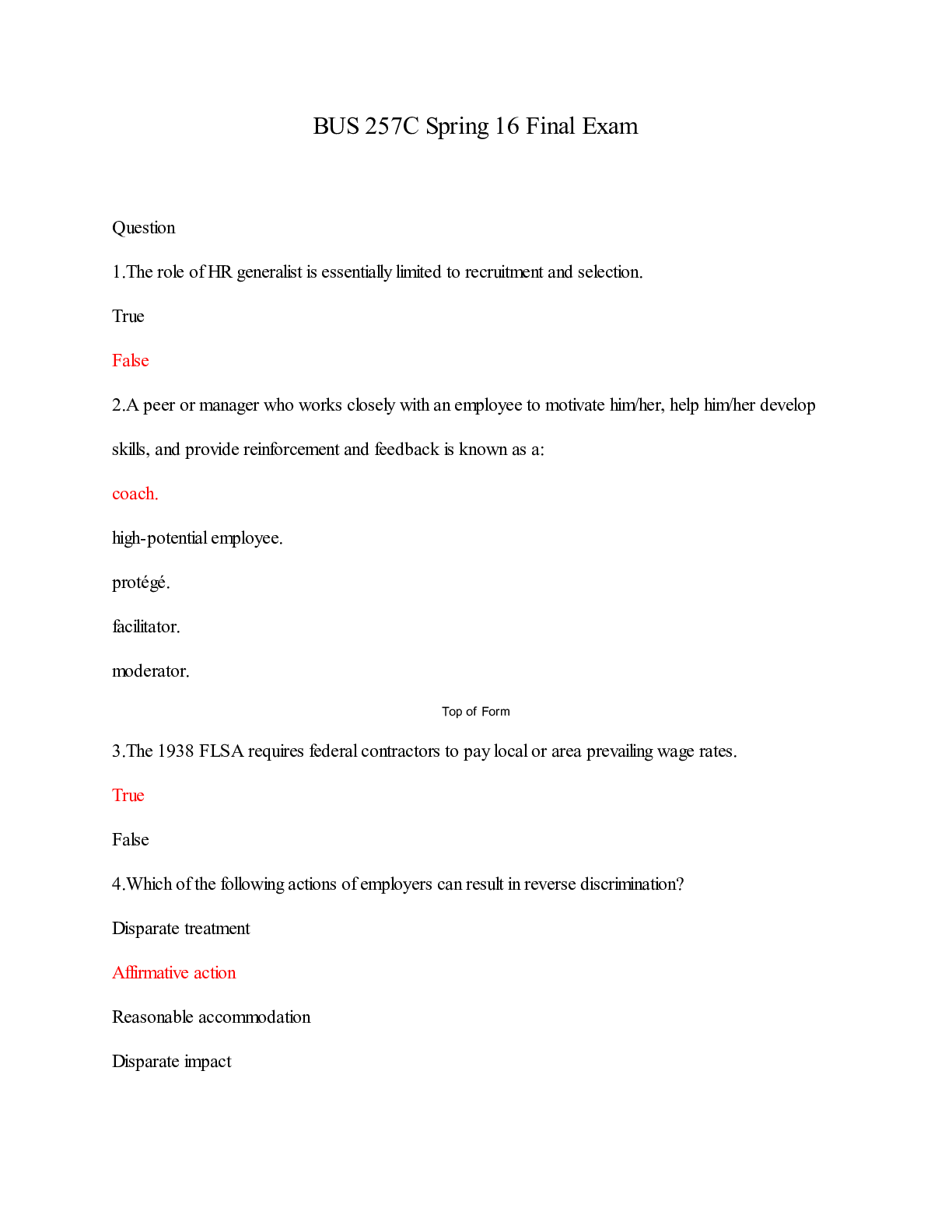


.png)
